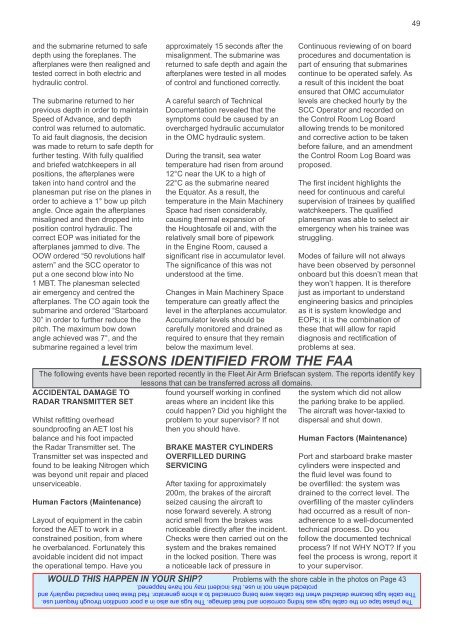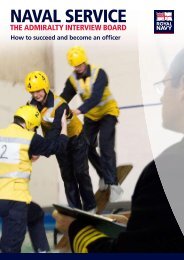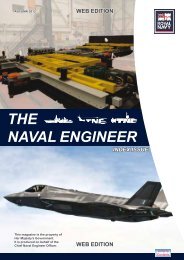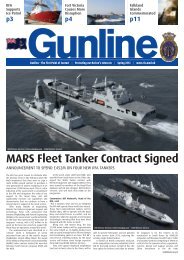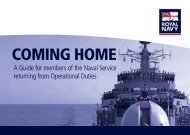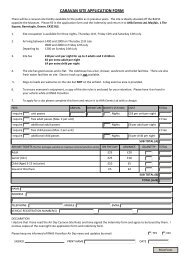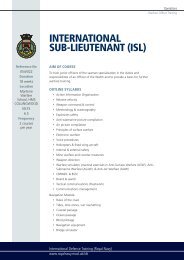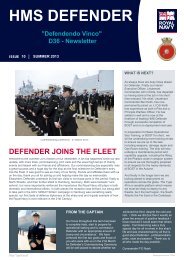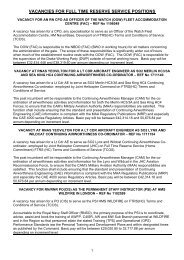THE NAVAL ENGINEER
THE NAVAL ENGINEER
THE NAVAL ENGINEER
Create successful ePaper yourself
Turn your PDF publications into a flip-book with our unique Google optimized e-Paper software.
49<br />
and the submarine returned to safe<br />
depth using the foreplanes. The<br />
afterplanes were then realigned and<br />
tested correct in both electric and<br />
hydraulic control.<br />
The submarine returned to her<br />
previous depth in order to maintain<br />
Speed of Advance, and depth<br />
control was returned to automatic.<br />
To aid fault diagnosis, the decision<br />
was made to return to safe depth for<br />
further testing. With fully qualified<br />
and briefed watchkeepers in all<br />
positions, the afterplanes were<br />
taken into hand control and the<br />
planesman put rise on the planes in<br />
order to achieve a 1° bow up pitch<br />
angle. Once again the afterplanes<br />
misaligned and then dropped into<br />
position control hydraulic. The<br />
correct EOP was initiated for the<br />
afterplanes jammed to dive. The<br />
OOW ordered “50 revolutions half<br />
astern” and the SCC operator to<br />
put a one second blow into No<br />
1 MBT. The planesman selected<br />
air emergency and centred the<br />
afterplanes. The CO again took the<br />
submarine and ordered “Starboard<br />
30” in order to further reduce the<br />
pitch. The maximum bow down<br />
angle achieved was 7°, and the<br />
submarine regained a level trim<br />
approximately 15 seconds after the<br />
misalignment. The submarine was<br />
returned to safe depth and again the<br />
afterplanes were tested in all modes<br />
of control and functioned correctly.<br />
A careful search of Technical<br />
Documentation revealed that the<br />
symptoms could be caused by an<br />
overcharged hydraulic accumulator<br />
in the OMC hydraulic system.<br />
During the transit, sea water<br />
temperature had risen from around<br />
12°C near the UK to a high of<br />
22°C as the submarine neared<br />
the Equator. As a result, the<br />
temperature in the Main Machinery<br />
Space had risen considerably,<br />
causing thermal expansion of<br />
the Houghtosafe oil and, with the<br />
relatively small bore of pipework<br />
in the Engine Room, caused a<br />
significant rise in accumulator level.<br />
The significance of this was not<br />
understood at the time.<br />
Changes in Main Machinery Space<br />
temperature can greatly affect the<br />
level in the afterplanes accumulator.<br />
Accumulator levels should be<br />
carefully monitored and drained as<br />
required to ensure that they remain<br />
below the maximum level.<br />
Lessons Identified from the FAA<br />
Continuous reviewing of on board<br />
procedures and documentation is<br />
part of ensuring that submarines<br />
continue to be operated safely. As<br />
a result of this incident the boat<br />
ensured that OMC accumulator<br />
levels are checked hourly by the<br />
SCC Operator and recorded on<br />
the Control Room Log Board<br />
allowing trends to be monitored<br />
and corrective action to be taken<br />
before failure, and an amendment<br />
the Control Room Log Board was<br />
proposed.<br />
The first incident highlights the<br />
need for continuous and careful<br />
supervision of trainees by qualified<br />
watchkeepers. The qualified<br />
planesman was able to select air<br />
emergency when his trainee was<br />
struggling.<br />
Modes of failure will not always<br />
have been observed by personnel<br />
onboard but this doesn’t mean that<br />
they won’t happen. It is therefore<br />
just as important to understand<br />
engineering basics and principles<br />
as it is system knowledge and<br />
EOPs; it is the combination of<br />
these that will allow for rapid<br />
diagnosis and rectification of<br />
problems at sea.<br />
The following events have been reported recently in the Fleet Air Arm Briefscan system. The reports identify key<br />
Accidental damage to<br />
Radar Transmitter set<br />
Whilst refitting overhead<br />
soundproofing an AET lost his<br />
balance and his foot impacted<br />
the Radar Transmitter set. The<br />
Transmitter set was inspected and<br />
found to be leaking Nitrogen which<br />
was beyond unit repair and placed<br />
unserviceable.<br />
Human Factors (Maintenance)<br />
Layout of equipment in the cabin<br />
forced the AET to work in a<br />
constrained position, from where<br />
he overbalanced. Fortunately this<br />
avoidable incident did not impact<br />
the operational tempo. Have you<br />
lessons that can be transferred across all domains.<br />
found yourself working in confined<br />
areas where an incident like this<br />
could happen? Did you highlight the<br />
problem to your supervisor? If not<br />
then you should have.<br />
Brake master cylinders<br />
overfilled during<br />
servicing<br />
After taxiing for approximately<br />
200m, the brakes of the aircraft<br />
seized causing the aircraft to<br />
nose forward severely. A strong<br />
acrid smell from the brakes was<br />
noticeable directly after the incident.<br />
Checks were then carried out on the<br />
system and the brakes remained<br />
in the locked position. There was<br />
a noticeable lack of pressure in<br />
the system which did not allow<br />
the parking brake to be applied.<br />
The aircraft was hover-taxied to<br />
dispersal and shut down.<br />
Human Factors (Maintenance)<br />
Port and starboard brake master<br />
cylinders were inspected and<br />
the fluid level was found to<br />
be overfilled: the system was<br />
drained to the correct level. The<br />
overfilling of the master cylinders<br />
had occurred as a result of nonadherence<br />
to a well-documented<br />
technical process. Do you<br />
follow the documented technical<br />
process? If not WHY NOT? If you<br />
feel the process is wrong, report it<br />
to your supervisor.<br />
Would This Happen in Your Ship? Problems with the shore cable in the photos on Page 43<br />
The phase tape on the cable lugs was hiding corrosion and heat damage. The lugs are also in a poor condition through frequent use.<br />
The cable lugs became detached when the cables were being connected to a shore generator. Had these been inspected regularly and<br />
protected when not in use, this incident may not have happened.


